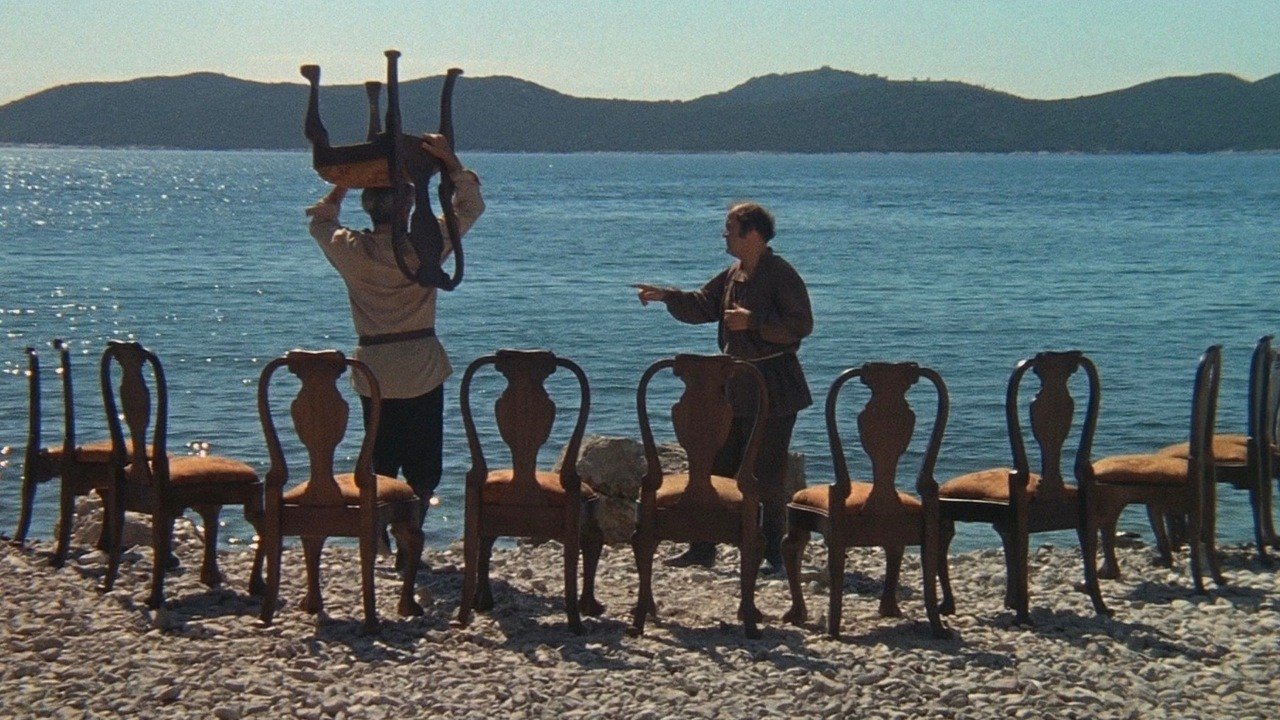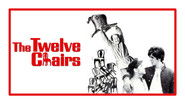Hunter Lanier
"Tragedy is when I cut my finger. Comedy is when you fall into an open sewer and die."Wiser words were never spoken--or promoted from theory to application as well as in Mel Brooks' adaptation of Ilf and Petrov's Russian novel, "The Twelve Chairs."The confession of a dying woman--that she's hidden jewels in one of twelve chairs--finds its way into the ears of three very different, but equally greedy, men. There's her son-in-law, Ippolit (Ron Moody), a man born with a silver spoon his mouth, which he proceeded to choke on. There's Ostap (Frank Langella, who, against all common wisdom, was once among the youth), a young con-artist whose first treachery is his fresh face. And lastly, there's Father Fyodor (Dom DeLuise), who seems less a product of seminary school than clown college.As with many of Mel Brooks' films, there's the foreground comedy and the background comedy, working simultaneously to their mutual benefit. The background jokes always get me, because I least expect them. For instance, the signs plastered all over Soviet Russia all seem to end in an exclamation point, no matter how trivial the message. Also, there's a hilarious theater troupe advertisement which reads, "Hamlet and the October Revolution by William Shakespeare and Ivan Poppov," in reference to Communism's "everything belongs to everybody" philosophy.While Langella is restricted to playing the straight man, both Moody and DeLuise are given total freedom to writhe, stretch their faces beyond the norm, and shout so much gibberish that by the end of the film, I think I began to understand. Moody's Ippolit, an otherwise timid character, is reduced to agitated mammal when possibly in the presence of the riches. DeLuise takes it farther, no better than in a tremendous scene where he finds himself in the home of a couple suspected of having the chairs. The physicality of his performance is top-notch, as he grovels and attacks, bouncing between affection and rage, unsure of which method is most likely to land him the chairs-- to the befuddlement of the couple, obviously. Despite having more of a dramatic core than Brooks' other films, "The Twelve Chairs" feels completely at home in Brooks' filmography. However, it's less broad than his films went on to be--there's no fourth wall breaking or seeing the orchestra on screen. It might have my single favorite showcase for character development, as a character fakes a seizure early in the film in a pathetically, doggy-paddle fashion; whereas later in the film, his method evolves into a loose, childlike dance. Bizarrely, this is only one of two satires of/by Russian literature done in the '70s by a Jewish comedian. The other is Woody Allen's "Love and Theft," which is better.
MartinHafer
A week ago, I saw the Cuban version of "The Twelve Chairs" and assumed it was the first version of the famous Ilf and Petrov novel. However, I researched a bit and found that there are at least two other versions out there--and possible more. In the 1930s, there was a Czechoslovakian filming of the story (the first) and then a British version as well. I also learned that all of these versions are different and not so bleak as the original story--a story where one of the partners in crime KILLS the other--only to learn that the jewels are not in any of the chairs. I could see how this version would be better for Soviet propaganda--but funny, no way. So the movie versions apparently have a more innocent and funnier slant--a good idea if you ask me.This Mel Brooks version is quite different from the Cuban one--much more slapstick, more cinematic and possessing much more energy. In fact, the lack of energy was my biggest complaint about the Cuban film. For a comedy, it was just too retrained. Here in the 1970 version, however, the opposite is true--at times the story has a bit too much energy and relies a bit too much on slapstick. For example, during a few scenes Brooks does something I HATE--speeds up the camera to indicate it's a funny scene. However, if it's funny, let it be funny on its own merit--don't do cheap camera tricks. Also, while adding a new character to the story was not necessarily a bad idea, Dom DeLuise's priest was, at times, over the top and didn't fit with the mood set by the rest of the film. Eliminating the camera tricks and keeping DeLuise under control would have improved the film immensely. Also, keeping Brooks out of the film completely wouldn't have hurt, either. I loved his writing and directing, but his best films had him barely in them (such as "The Producers" and "Young Frankenstein").Now I have criticized the film quite a bit--but there is a lot to like and I think it's one of Brooks' better films. The most obvious plus in the film was the wild and crazy performance by Ron Moody. Because Moody had many quiet and restrained moments, his crazy scenes worked well. For example, while a generally restrained man, seeing him, out of the blue, climb up the pole to the high wire was hilarious. And, a few other times when he lost control, couldn't help but smile. RESTRAINT and selective craziness was what made him a joy to watch.I also respected the nice location shoot in Yugoslavia. It could have been made in the States but filming in a locale more like the USSR helped--and there was no way the Soviet Union would have allowed the film to be made there considering the state of US-USSR relations at the time. The color cinematography and locations shoots were nice.I was surprised, but Brooks' song "Hope For The Best, Expect The Worst" was also a wonderful song. It was catchy, summed up the film well and I found myself humming it after the movie was over.Finally, I liked the relationship between Moody and Frank Langella--particularly at the end of the movie. Going for a sentimental ending with some pathos was a great idea--and ending it like the novel would have been just awful.Overall, while I am sure many would disagree, I think that apart from "The Producers" and "Young Frankenstein" this was Brooks' best film. There is a likability and subtle (at times) that you just never see in his later films...and I like this and find it endearing. Too bad his films became progressively goofier and self-indulgent.
artasscorp1984
This movie is not even close to the REAL classic 12 Chairs 1971 movie by Leonid Gaiday. The problem is not in the director or actors. Brooks may be a good director, whatever, the facts are that American nation will never understand the classic Russian humor the way it's meant to be.The Russian 1971 version of 12 chairs together with "adventures of Shurik" is widely considered to be simply the best Russian comedy of all time. Watching American 12 chairs version would be the same as forcing Pierre Richard to play a Schwarz's roles. Ridicioulus...I can't believe that people like this movie and have read the novel at the same time, this is hard to understand...Don't watch this movie! Watch classic 1971 and 1976 Russian movies instead!
thinker1691
In his lifetime Mel Brooks has created many motion pictures which have established him as an artistic genius. "The Twelve Chairs" is another milestone for him. From the very beginning of this film, to its ending, there is a sense of serious, but humanistic brilliance. The era is the aftermath of the Russian Revolution and a dying woman wants to clear her conscience and reveal her greatest sin. As thousands of the nobility are fleeing for their lives, she decides to hide her family's fortune inside the lining of a set of handcrafted chairs. That secret is her dying revelation and is said unfortunately into more than one set of ears. This initiates a mad dash for the lost treasure. Seeking the cache of jewels are three intrepid, but greedy set of characters. The first is incredibly talented Ron Moody who adroitly and brilliantly plays the legitimate, greedy and opportunistic son, Ippolit Vorobyaninov. Once a Marshall of the nobility, he is now reduced to a minor banking clerk and opportunistic son-in-law. Frank Langella is superior as Ostap Bender, a handsome, street-wise, traveling Gypsy, who also wants in on the treasure hunt. Finally there is Dom DeLuise who plays Father Fyodor, an Orthodox but impoverished monk who believes, God will help him find the elusive chair first. What the trio soon discover is that the chair is one of Twelve which have been scattered across the vast twelve thousand miles of Russia. If Mel Brooks sought to create an amusing memorable movie, he succeeded. By the time one reaches the end of this film, we realize . . . . a Classic has been born. ****


 AD
AD




